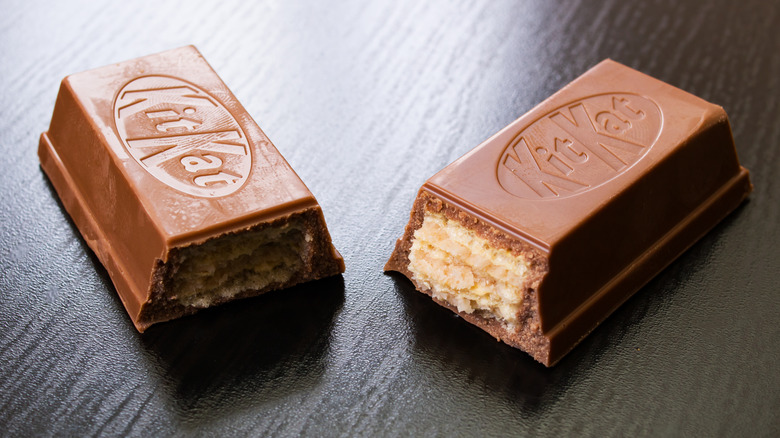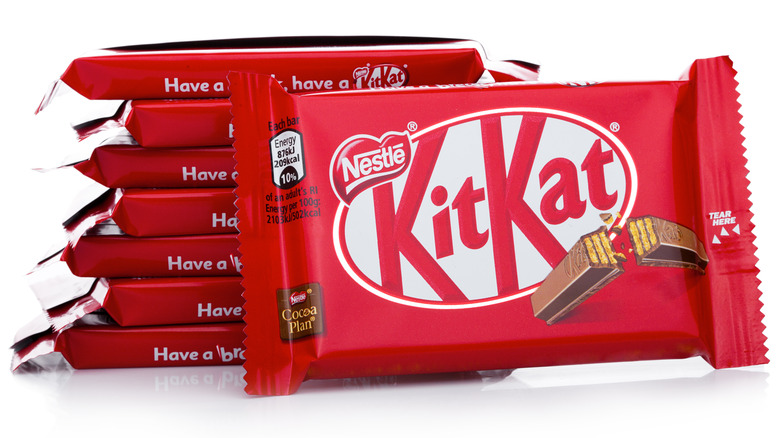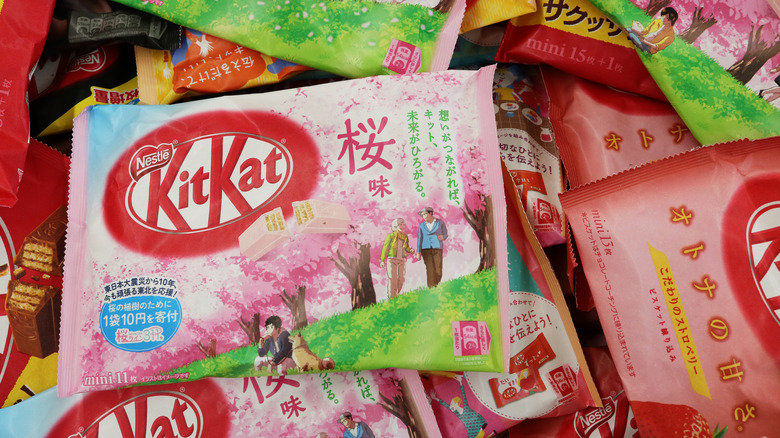The Country Responsible For The Creation Of Kit Kat Bars
People have been breaking off pieces of Kit Kat bars for a long time, and the idea of taking a "break" has been wrapped up with the candy for as long as it's been around. According to The Hershey Company, the treat's original slogan referred to it as "the biggest little meal," indicating that it was more than just a dessert or snack; it was something worth taking the time to savor. By the mid-20th century, "have a break, have a Kit Kat," became the tagline, further emphasizing this point. Per Creative Review, this catchphrase graced many TV screens via ads that often used relatability and comedy to lure customers into their product's narrative. Later, in 1988, the "Gimme A Break" jingle debuted, kicking off the modern era of Kit Kat breaks.
What exactly is a Kit Kat bar, though? Chocolate surrounding crispy wafers with thin layers of filling (via The Takeout). Surprisingly, Kit Kat bars themselves are actually an ingredient of Kit Kats, too, per the New York Post; when in-progress bars break at the factory, they're crushed, sweetened, and mixed into the paste that holds the wafers together. Such a strange factoid is just one of the many things people often don't know about Kit Kat bars. One other obscure piece of trivia concerning the candy is their origin point.
Across the pond
Kit Kat bars are British. In York, England during the 1800s, an individual named Henry Rowntree bought a grocery store and cocoa foundry, naming them Rowntree's, and then began to make chocolate candy (via the New York Times). In 1935, that business created "Rowntree's Chocolate Crisps," which were renamed "Kit Kat Chocolate Crisps" a mere two years later, per The Hershey Company. This shift towards less literal branding seems to have worked well, considering how popular the candy has since become.
Kit Kat bars can now be found in all sorts of different flavors and sizes all over the world. As noted by Nestlé – Kit Kats belong to both Hershey and Nestlé – 1944 saw the introduction of dark chocolate Kit Kats, 1960 brought on the invention of two-finger Kit Kats, and the turn of the millennium coincided with variations like Kit Kat Chunky and Kit Kat ice cream. The candy has spread to over 80 different countries now, with flavors like apple pie, birthday cake, lemon, milk chocolate, and white creme in the United States. At the end of the day, though, Kit Kats are a United Kingdom creation.
Big in Japan
Kit Kat bars might come from England, but we'd be remiss not to mention their huge success in Japan. Per Nestlé, the country has, for example, a Kit Kat Chocolatory where customers can make their very own bars. According to the Los Angeles Times, the nation also features unique takes on the treats, such as gold-leaf covered Kit Kat bars, as well as flavors like cherry blossom, green tea, sake, and wasabi. Coincidentally, "Kit Kat" sounds like "kitto kattsu," a Japanese phrase that translates to "you will surely win," serendipitously underlining the candy's positive reputation there.
Kit Kats arrived in Japan in 1973, and over time, the brand saw an opportunity to elevate itself to souvenir status. That's why strawberry, one of the first novelty flavors, was introduced, and its success sparked further creativity. The New York Times reports that Kit Kats can now be found not only in drugstores there but in department stores and luxurious boutiques, as well. Plus, visitors from all over the world collect their unique flavors to bring home as keepsakes and novelties. All the way from England to Japan, Kit Kat bars are truly a global phenomenon.


